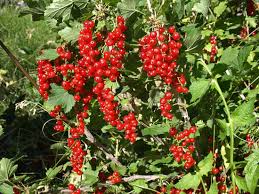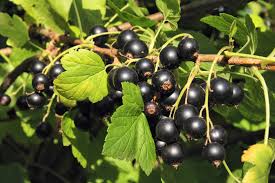by Tom Gibson
Currants–red, black, pink, etc.–are something of a mystery to Americans. Faced with a bush brimming with ripe berries, even Americans with broader-than-average taste palettes will look, admire….and then walk right by. That was my experience this last summer, at least, in a community garden with eight or so free-to-member bushes. I’d pick several pounds of bright red berries, wait an interval of several days for others to take their turn, and the bushes would remain almost as full as before. Why the lack of interest?
For the perennial/permaculture gardener that is no idle question. For currants happen to be easy to grow, fruit prolifically in both shade and sun, and are virtually immune to deer pressure. And they’re a staple of European cuisine–from the UK through to Russia. So what’s the problem?
First, they’re sour. You can’t just pick and eat. So that means, second, that they require processing. Europeans juice them and serve with breakfast. If that’s too bracing, one could mix them into smoothies with blander fruit like bananas or pawpaws. My wife and I used the latter, and the results are tasty.
Third, Americans don’t have a tradition of cooking with them, so we don’t have much choice of currant recipes for more complicated cooking.
Through the miracle of the Internet, however, those recipes are now at our fingertips. But–and this is the fourth barrier–those recipes are often in a foreign language. That creates a real mental barrier, to be sure, but one that can be easily surmounted with a fool-proof search strategy and a simple right click.
Here’s a take-home-exercise–the first, I believe, in Gardenopolis Cleveland history. First, pick an ingredient, in this case “red currants” and the word “recipe” and then “translation” and the European language of your choice. Second, inspect the foreign language recipes and their pictures. Click on one you think might be interesting and then right click for an instant translation into English.
Here’s an example. Having followed step one for German, we get “Rote Johannisbeeren” and “Rezept”. After inspecting our many choices, we click on the following link: http://www.chefkoch.de/rezepte/1410421245910330/Rote-Gruetze.html. Now right click and then click on “Translate into English.” Voila! A delicious, yet simple, way to serve both red and black currants.
Finally, here’s link to a recipe (in English!) for red currant pie that we have made several times and that has proven a big hit with company. http://allrecipes.com/recipe/18480/red-currant-pie/. The lemon in the crust plays nicely off the red currants in the filling. My wife advises that, if you have too much difficulty rolling out the sticky dough, just add a little more flour and “pat” (rather than “roll”) the dough into place. The only other change to the recipe my wife makes is to drizzle the top with melted semi-sweet chocolate. Without that, the resulting pink filling looks too much to us like Pepto Bismol.



I have been growing and preparing red, white, pink and black currants for decades, ever since some bushes fruited on the property we first rented and I was introduced by accident. There are two books, both in English, that I prize for their recipes. One is by JoAnn Gardner, The Old-Fashioned Fruit Book, and the other is by Jane Grigson, a very popular and famous author whose fruit recipes are wonderful as is her commentary. I have been making crème de cassis for decades out of the black currants which I cultivate lovingly now, having found them bit by bit from various nurseries after the initial problems with shipping non-white pine blister resistant kinds to Ohio. Be patient and you shall receive. I have never made the pie, but my shelves are currently (no pun intended) stocked with many jars of home grown home made recipes, and red currant and crème de cassis are of course the best. Thanks Tom for sharing. If you cannot find the Gardner book I have extra copies and will share. Crème de cassis–maybe I would give you a taste if asked. Coincidentally a recipe for it appears in JoAnn’s book, attributed to Jane Grigson.
Creme de cassis sounds great. Consider this an “ask!” 🙂